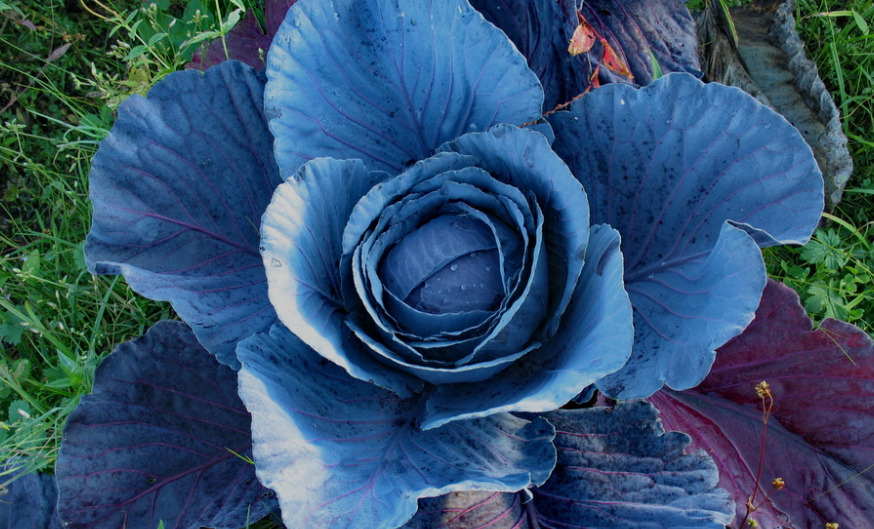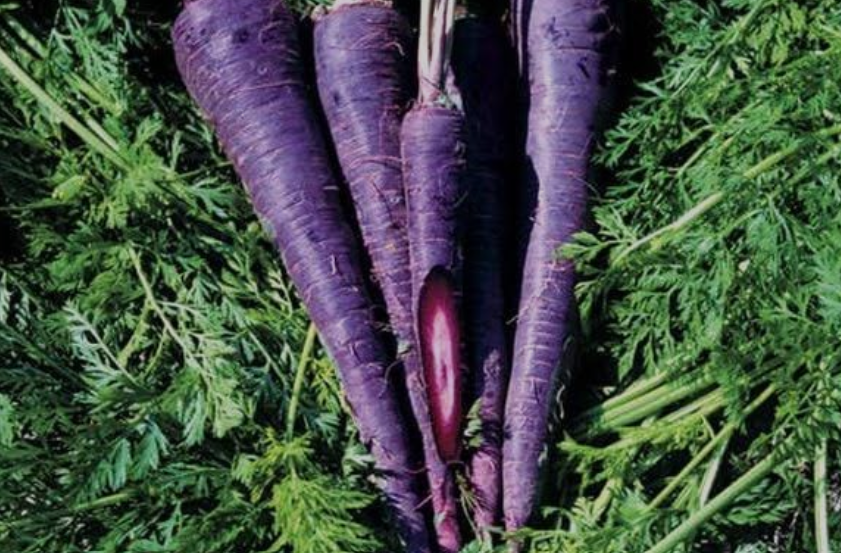
Naturally blue vegetables are some of the rarest in the plant world. Their blue or bluish-purple color comes from anthocyanins, a group of pigments that also act as antioxidants. Their unique coloration comes from anthocyanins, a type of flavonoid pigment that provides powerful antioxidant properties. These compounds not only give the vegetables their blue or bluish-purple hue but also help protect the plant from ultraviolet light and oxidative stress. The rarity of naturally blue vegetables makes them particularly valued for both aesthetic appeal and nutritional benefits
Blue vegetables are highly nutritious. The anthocyanins responsible for their color have been linked to reduced inflammation, improved cardiovascular health, and enhanced brain function. Many naturally blue vegetables also contain vitamins, minerals, and dietary fiber, supporting digestion, immunity, and overall wellness. Vegetables like blue potatoes, blue corn, and purple cabbage are especially valued for their antioxidant content, which can help neutralize harmful free radicals in the body.
Culinary uses of naturally blue vegetables are wide-ranging and versatile. They can be eaten raw in salads, lightly steamed, roasted, or incorporated into soups and stir-fries. Blue vegetables are also used in purees, chips, and even natural food coloring. Their unique color can enhance the visual appeal of dishes, making them ideal for gourmet presentations or vibrant everyday meals. Some blue vegetables, like butterfly pea flowers, even change color when cooked with acidic ingredients, creating dynamic visual effects in beverages and dishes.
Geographically, blue vegetables are cultivated in various parts of the world. Blue potatoes and blue corn are grown in North and South America, while blue eggplants, blue sweet corn, and butterfly pea thrive in tropical and subtropical regions of Asia. These vegetables have adapted to different climates and soil types, allowing them to be integrated into regional cuisines and traditional dishes while also supporting local agriculture.
Geographically, naturally blue vegetables are found in both temperate and tropical regions. Blue potatoes, blue corn, and kale varieties are cultivated in North and South America, while blue eggplants and blue sweet corn are grown in tropical and subtropical climates. Other blue plants, such as butterfly pea and blue pea shoots, thrive in Asian and Southeast Asian regions. These vegetables have also adapted to local climates and soils.
In modern diets, naturally blue vegetables are increasingly recognized as superfoods due to their combination of nutrients, antioxidants, and visual appeal. They are embraced by chefs, nutritionists, and home cooks alike.

Blue Vegetables And Their Use
Blue Potatoes (Solanum tuberosum)
Blue potatoes have deep blue or purple skin and flesh. They can be boiled, roasted, or mashed like regular potatoes, and their striking color remains relatively stable when cooked. They are often used in salads, baked dishes, or as colorful chips.
Blue Corn (Zea mays var. amylacea)
Blue corn has dark bluish kernels and is commonly ground into flour or meal. It is used to make tortillas, chips, cornbread, and porridge. It contains higher levels of antioxidants than yellow corn, adding nutritional benefits to traditional dishes.
Blue Carrots (Daucus carota subsp. sativus)
Originally cultivated in purple and blue varieties, these carrots are sweeter than some orange carrots and contain anthocyanins concentrated in their skin. They can be eaten raw, roasted, juiced, or added to soups and salads for color contrast.
Blue Cabbage (Brassica oleracea var. capitata f. rubra)
Also known as red cabbage, its bluish-purple hue appears more pronounced in certain soil and pH conditions. It is used raw in salads, fermented as sauerkraut, or cooked in stir-fries and braised dishes, often changing color depending on acidity.
Blue Tomatoes (Heirloom Varieties)
Some heirloom or hybrid tomatoes, like Indigo Rose, develop deep blue to purple skin while remaining red inside. These tomatoes are used fresh in salads, roasted, or made into sauces, and are particularly valued for their antioxidant-rich skin.
Blue Beans (Phaseolus vulgaris)
Certain bean varieties, like Blue Lake beans, have a bluish tint to their pods. They are used similarly to green beans—steamed, boiled, or stir-fried—and add a unique color to vegetable medleys or side dishes.
Blue Kale (Brassica oleracea var. sabellica)
Some kale cultivars, such as ornamental blue or purple kale, have bluish or violet-tinged leaves. They are used in salads, smoothies, soups, or baked into kale chips, providing both nutrition and aesthetic appeal.
Blue Eggplant (Solanum melongena)
Many eggplant varieties have a deep blue or purple skin. They are versatile in cooking—grilled, roasted, baked, or stir-fried—and are commonly used in stews, dips like baba ganoush, or curries.
Blue Peas (Clitoria ternatea)
Also called butterfly pea, the blue flowers of this plant are edible and used for coloring food and drinks. The petals can be brewed into tea, which turns bright blue and can change to purple with acidity. The flowers are also used in rice dishes, desserts, and natural food coloring.
Blue Spirulina (Blue-Green Algae, Arthrospira platensis)
Though technically a cyanobacterium, blue spirulina is often used as a vegetable-like supplement for its vibrant blue pigment, phycocyanin. It is added to smoothies, juices, desserts, and even pasta for natural coloring and its antioxidant properties.
Blue Sweet Corn (Zea mays var. saccharata)
Different from blue field corn, this variety has tender, sweet kernels with a bluish hue. It is eaten fresh, boiled, roasted, or incorporated into salads, salsas, and side dishes.
Blue Cucumber Varieties (Cucumis sativus)
Certain cucumber cultivars, such as some heirloom or ornamental types, have bluish-gray skin. They are crisp and refreshing, eaten raw in salads, sandwiches, or pickled for unique flavor and color.
Blue Cabbage Sprouts (Brassica oleracea)
Sprouts of blue or purple cabbage are edible and packed with nutrients, including anthocyanins and vitamin C. They are used raw in salads, sandwiches, or as a garnish for soups and grain bowls.
Blue Cornflower Leaves (Centaurea cyanus)
While primarily considered an edible flower, the young bluish leaves of cornflower can be used in salads, garnishes, or herbal teas, adding both nutrition and color to dishes.
Blue Radish Varieties (Raphanus sativus)
Some heirloom radish varieties have bluish-purple skin and flesh. They are crunchy and mildly peppery, eaten raw in salads, pickled, or roasted for a colorful vegetable side dish.
Blue Mustard Greens (Brassica juncea)
Certain mustard green cultivars have bluish to purple tints in their leaves. They can be sautéed, added to soups, or used in salads, offering a peppery flavor along with antioxidants.
Blue Lettuce Varieties (Lactuca sativa)
Some heirloom lettuce types display bluish or violet hues, particularly around the edges of the leaves. These are eaten fresh in salads, sandwiches, or wraps for added color and nutrients.
Blue Kohlrabi (Brassica oleracea var. gongylodes)
Certain kohlrabi cultivars develop bluish-purple skin. The bulbs are crisp and mild, eaten raw in slaws or salads, or cooked by steaming, roasting, or stir-frying.
Blue Potimarron Squash (Cucurbita maxima)
Some heirloom winter squash varieties develop bluish-gray skin. The flesh is sweet and nutty, making it ideal for roasting, soups, or purees.
Blue Artichoke (Cynara scolymus ‘Blue’)
Certain ornamental or heirloom artichoke varieties have bluish-purple bracts. These can be cooked like regular artichokes—steamed, roasted, or grilled—and are visually striking in dishes.
Blue Carrot Tops (Leaves of Blue Carrots)
The leafy greens of blue carrot varieties often have a slight bluish or purple tint. They are edible and can be sautéed, added to soups, or used as a garnish, providing nutrition similar to other carrot greens.
Blue Japanese Eggplant (Solanum melongena)
Some Japanese eggplant cultivars have deep blue-purple skin. They are tender and versatile, ideal for grilling, roasting, stir-frying, or incorporating into curries and stews.
Blue Spinach (Amaranthus tricolor var. ‘Blue’)
Certain amaranth or spinach cultivars have bluish leaves. They are rich in vitamins and minerals and can be used in stir-fries, soups, or fresh salads.
Blue Pea Shoots (Clitoria ternatea)
The young shoots and leaves of the butterfly pea plant have a bluish tint and can be used like microgreens in salads, sandwiches, or garnishes, often paired with the edible flowers for a vivid presentation.
Blue Chard (Beta vulgaris subsp. cicla)
Some chard cultivars have bluish to purple stems and leaves. They are nutritious and versatile, perfect for steaming, sautéing, or adding to soups and grain bowls.
Blue Rutabaga (Brassica napus subsp. rapifera)
Certain rutabaga varieties develop bluish or purplish skin. Their sweet, earthy flesh can be roasted, mashed, or incorporated into stews and casseroles.
Blue Broccoli (Brassica oleracea var. italica ‘Blue’)
Some broccoli cultivars, like the heirloom purple sprouting types, show a bluish-purple hue. They can be steamed, roasted, or stir-fried, and retain antioxidants even when cooked lightly.
Blue Fennel (Foeniculum vulgare var. purpureum)
Certain fennel varieties have bluish or purple stems and fronds. They add a mild anise flavor to salads, roasted dishes, or herb blends while providing an unusual color accent.